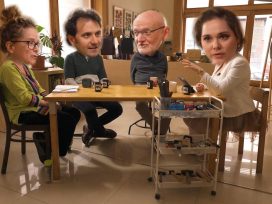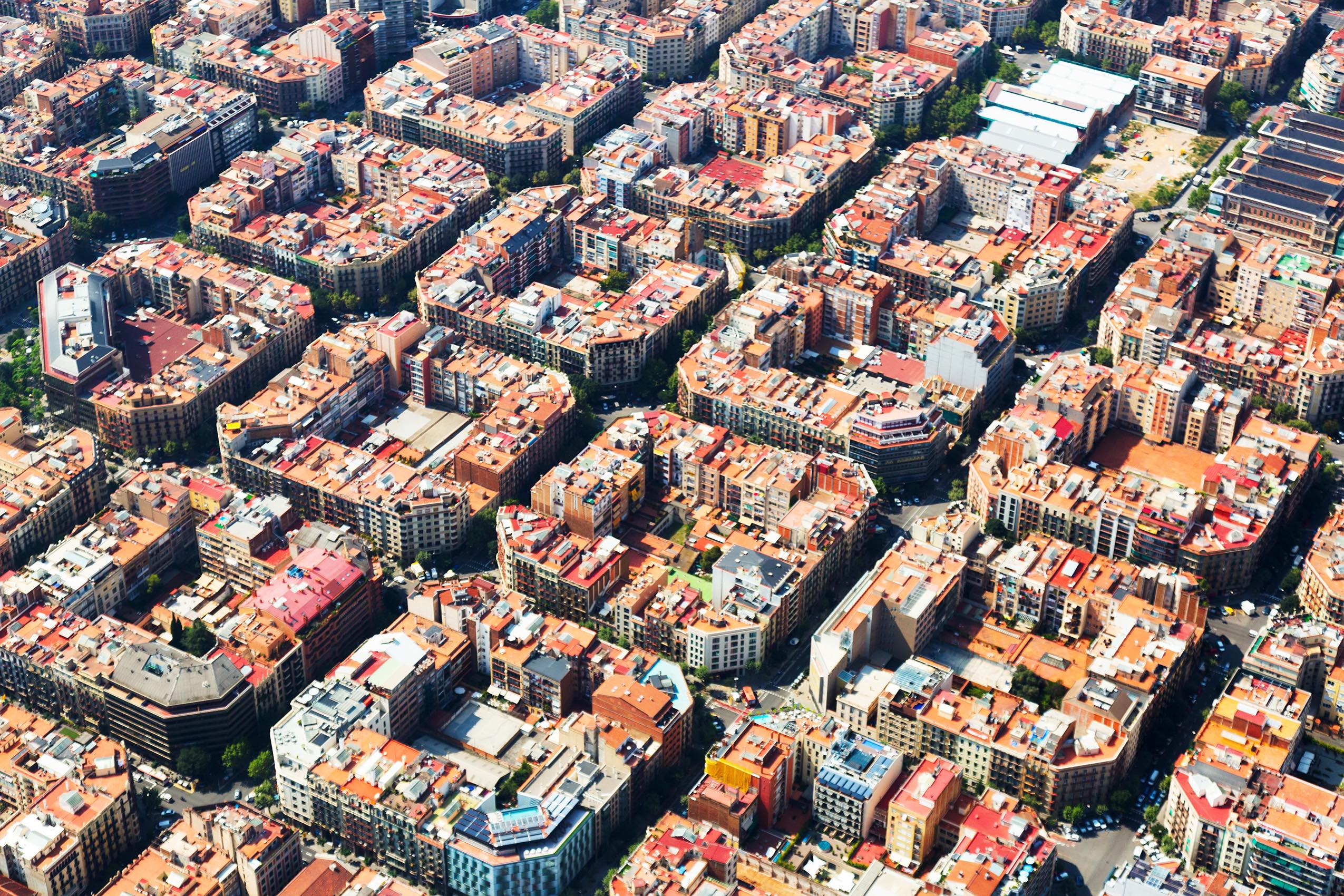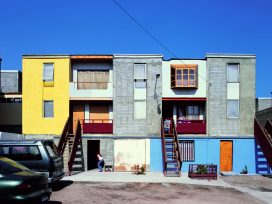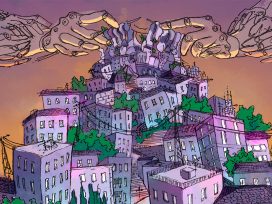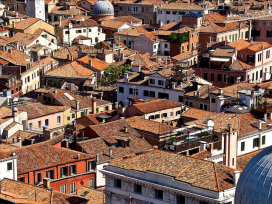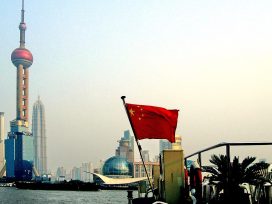The question of ‘the city’ has preoccupied me for a long time. My latest book, The Open City, is the last of a trilogy on Homo Faber, human beings, man and woman, as makers. The first book was on craftsmanship, the second was a book on cooperation, and this is a book about making the physical environment.
For the last 38 years I’ve been a consultant for various bodies of the United Nations, mostly concerning public space, and this work has taken me out of my comfort zone. I’ve had to learn to new ways of seeing the city. I wrote on a lot of those practical experiences in this rather theoretical book, as this is a legacy of my urbanism.
Working for the UN, we have to be very diplomatic when we go as outsiders to cities. I had to repress my own political beliefs when working on these projects. I’m going to release them now. First I’ll tell about the structural contradiction between building and dwelling, between creating a design or a project and living in it. Then I’ll talk about how a democratic struggle for a city can be formulated, concerning open and closed cities. And then I’ll show you specific instances of these theoretical issues.
Ville and cité: The two meanings of city
In early Christianity, ‘city’ stood for two cities: the City of God and the City of Man. St Augustine used the city as a metaphor for God’s design of faith, but the ancient reader of Augustine who wandered the alleys, markets and forums of Rome would have got no hint of how God worked as a city planner. Even as this Christian metaphor waned, the idea persisted that ‘city’ meant two different things – one a physical place, the other a mentality compiled from perceptions, behaviours and beliefs. The French language first came to sort out this distinction by using two different words: ville and cité.
Initially, ville referred to the overall city, whereas cité designated a particular place. Some time in the sixteenth century, the cité came to mean the character of life in a neighbourhood, the feelings people harboured about neighbours and strangers, and attachments to place. This old distinction has faded today, at least in France; a cité now most often refers to those grim locales which warehouse the poor on the outskirts of towns. The older usage is worth reviving, though, because it describes a basic distinction: the built environment is one thing, how people dwell in it another.
This became clear to me in the first job I had as a practical planner in Boston. I worked in a project which attempted to integrate the city’s schools by bussing children out of the black community into more middle-class white districts. As Donald Trump has highlighted, racism is a very strong component of American life. In some ways it’s the strongest component. These middle-class white people resisted our imposition of black children in a very clever way. To bus children into a school, the busses need somewhere to park, so we needed to build parking lots. White parents said it was un-ecological; they wanted parks rather than parking lots. The subtext being that without a place to park, the children wouldn’t come. I was pleased that my bosses didn’t succumb to class guilt and went ahead with the project, even though it engendered fairly violent activities by white parents in the city, menacing these black children.
This is a basic element of the relationship between building and dwelling: an asymmetry, a conflict. Normally we think that planning should do what people want, that building should follow dwelling. But when people want something unjust, the planner has an obligation to resist the community in the name of justice. Working with the UN, most people who had a say in big cities wanted us to build gated communities to keep out the immigrants and the poor. A planner has to resist that.
This is a two sided relationship. Global capitalism employs planners as poodles, to design environments for repressive investments. There is also a structural conflict between how people want to live, how they are obliged to live, and how cities are built. That basic problem occurred to me early on in my life; I find it a pervasive tension in cities of the emerging world today. Some clarification of this structural tension might help us, if not to resolve or end it, then to approach it in a more positive way. That brings me to the relationship between open and closed cities.
Open cities versus closed cities
An open city is a democratic one which sometimes has to be opened in undemocratic ways. Yet closed cities can also often be desirable to live in. The question for us is how to gradually open a city in a way that keeps it desirable for dwelling, instead of gratifying people’s will for closed cities.
It occurred to me when working at the Massachusetts Institute of Technology, where I began my career in urbanism in the early 80s and 90s. My office was near the media lab, kind of a frenzied centre of creativity using new media. My strongest memory is of its smell. People were in there 24 hours a day obsessed with their projects. There were pizza cartons everywhere and a thick atmosphere of hard smells and that reminded me of what the open city often means to me.
The people working there had an interesting distinction between a Microsoft kind of experiment and a media lab experiment. A Microsoft experiment for them was something that tested a hypothesis: either true or false, the conditions of its closure are known in advance. That is a very operational way of conducting research and getting results. Whereas a media lab experiment was interested in difficulties and obscurities. It was interested in why things didn’t work, in sudden discoveries that didn’t make any sense. The people in the media lab contrasted these as the difference between thinking in a closed or an open way about research.
I should also say that the media lab was supported by Microsoft. So this is a way of literally biting the hand that fed you the pizzas. It resonated with me largely because it reflects two different social systems. A closed system is one in which the parts add up to the whole. There is not much interaction between them. It’s an additive system, in which you specify the conditions and you see whether they are right or wrong. A closed system looks for clarity of results, whereas an open system is more experimental. It’s interested in wrong answers.
Somebody said to me once: a wrong answer is something you want to dwell in, a right answer is just something to operationalize. This is a very profound remark on how thinking in an open way is about complexity rather than clarity. Open thinking prefers non-linear paths of exploration. It emphasizes the whole being more than the sum of its parts.
Complexity instead of clarity
I applied this idea of open systems to urban conditions. It wasn’t entirely my invention. The architect Robert Venturi once wrote: ‘I like complexity rather than clarity. I like the built environment to reflect the uncertainties and difficulties of how people live rather than showing them a clear way to live.’ In modern capitalism, however, vectors tend towards closure rather than openness. International capital, for instance, doesn’t invest in problematic sites. It’s much easier to grade the site flat, to take it down to the ground and start over, so that you know exactly what you’re getting.
Working with the UN I started to think more and more about how capitalism is closing cities, which sometimes coincides with inhabitants’ desires to get away from difficulties, from other people in the city: to flee difference. Seeing that as a dominant mode of urban development, I wondered what could resist it. Dealing with the physical environment, I could see alternative structures, but I also learnt that it requires a different type of power to impose those changes in a city.
Architects and planners, a rather immodest group of human beings, often fantasize about some kind of ideal plan which will knock down capitalism and represent exactly how people should live instead. I don’t believe in that. For me the question is, once you have the instruments of power, whether you resist or take control. What kind of city do you want to make?
Building versus dwelling
In line with the structural contradiction between building and dwelling, there isn’t one image you can hold up and say: this is an open city, this is what all open cities should look like. There are alternatives that are themselves problematic; each of them are attractive and unattractive at the same time. I feel a little bad talking about how to resolve the democratic crisis of cities by making them more open, because there isn’t a universal ideological formula that does that. I’ll now show physical alternatives between open and closed environments.x
The power relations are built into these physical forms, but often those power relations are not discursive objects. I don’t think you could form a political party around open forms of housing, for instance. My urbanism tends to be much more about the non-verbal than the verbal, the experience of form physically rather than explained ideologically. It is true of the theoretical books I have written, and is also true of the practical work that I’ve done as a planner which, thank God, I have retired from.
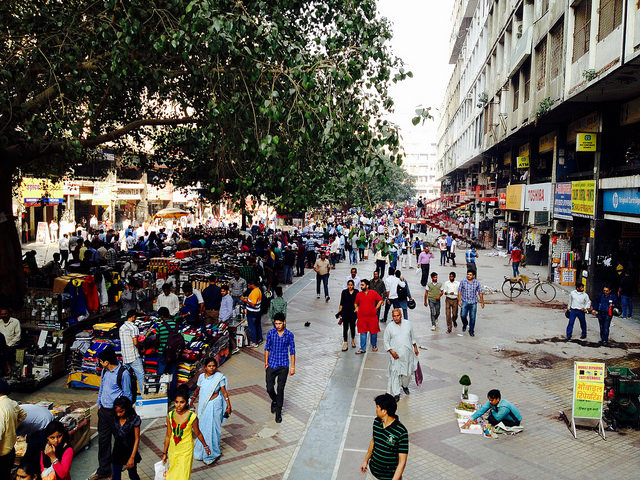
An open space today: Nehru Place in Delhi, used by pavement dwellers, hawkers of stolen electronics and sari sellers, its sides lined by start-up firms. Photo courtesyí of Richard Sennett
First of all, I want to show a contrast between open and closed form. This is an open place: one image of an open city, from South Delhi. The platform here is actually the top of a three-storey underground parking garage. Originally these were government offices for civil servants in Delhi. The city got richer, the civil servants moved to quarters more worthy of them and the public flooded in here to do something. This is an area with a very particular character, this is the Silicon Valley of Delhi. Mostly people are selling illegal software, programs or illegal phones. On the side are the offices of software start-up firms, people who repair faulty phones, and so on. What makes this an open space is not only it’s informal economy, or that the space is physically open, since it’s just the top of a parking garage. There are about 46 to 58 thousand people here everyday, and the electronics retailers and the start-up workers are a mix of Hindus and Muslims. This is the safest part of Delhi. It has had the least violence of any public space in the city, precisely because these very different people are mixed physically together, engaged in a common activity of either creating new software or of selling existing goods. Beside those working with advanced tech there are people who sell saris, chapatis and all sorts of things. At night these trades people depart and a huge number of pavement dwellers occupy the space. We intervened in this project because it’s under threat: investors want to tear it down to build a skyscraper. We are trying to list this place as a UNESCO world heritage site. It is grotesque that an open city has to be officially protected.
That is an example an open city in an Indian context. It contrasts with central Shanghai. This is a closed system, it does not relate in any way to the transport system or to the space underneath it. Functions don’t mix here. That is a great problem for people in Shanghai now: the place was built in a time of economic prosperity, but now they realize that it’s dysfunctional because it’s too formalized.
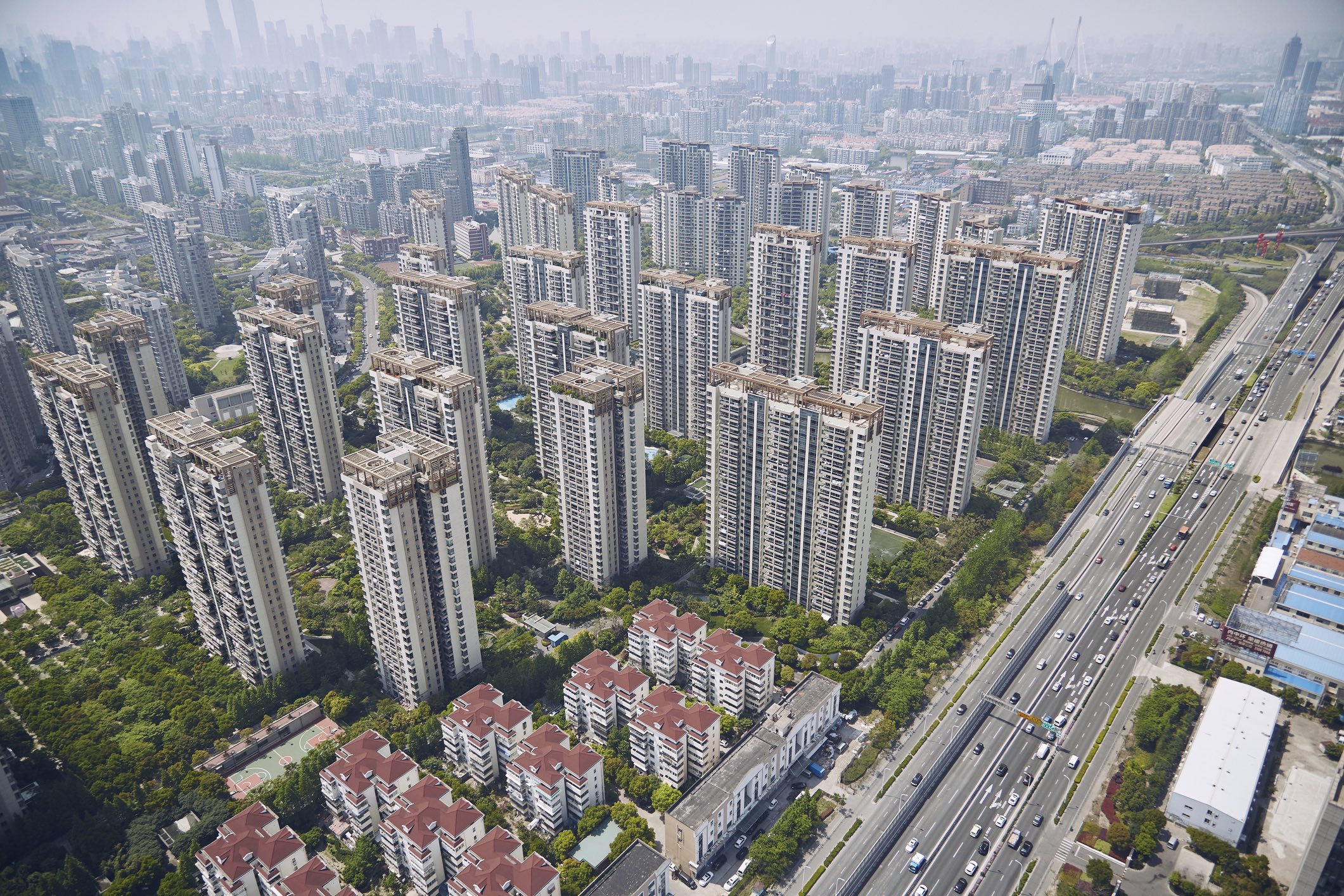
Highrise apartment buildings on the Pudong side of Shanghai seen from the air. Visible in the background is the heavy air pollution. Photo courtesy of Richard Sennett.
Here is another example: workers’ housing in Beijing. Physically it is of good quality, it’s got flush toilets, the water and electricity systems are fine. Yet now it has all sorts of social problems that result from living an isolated place with no public space. There is no place for kids to hang out, elderly people are imprisoned alone in these flats. It’s a space in which formalization has killed sociability.
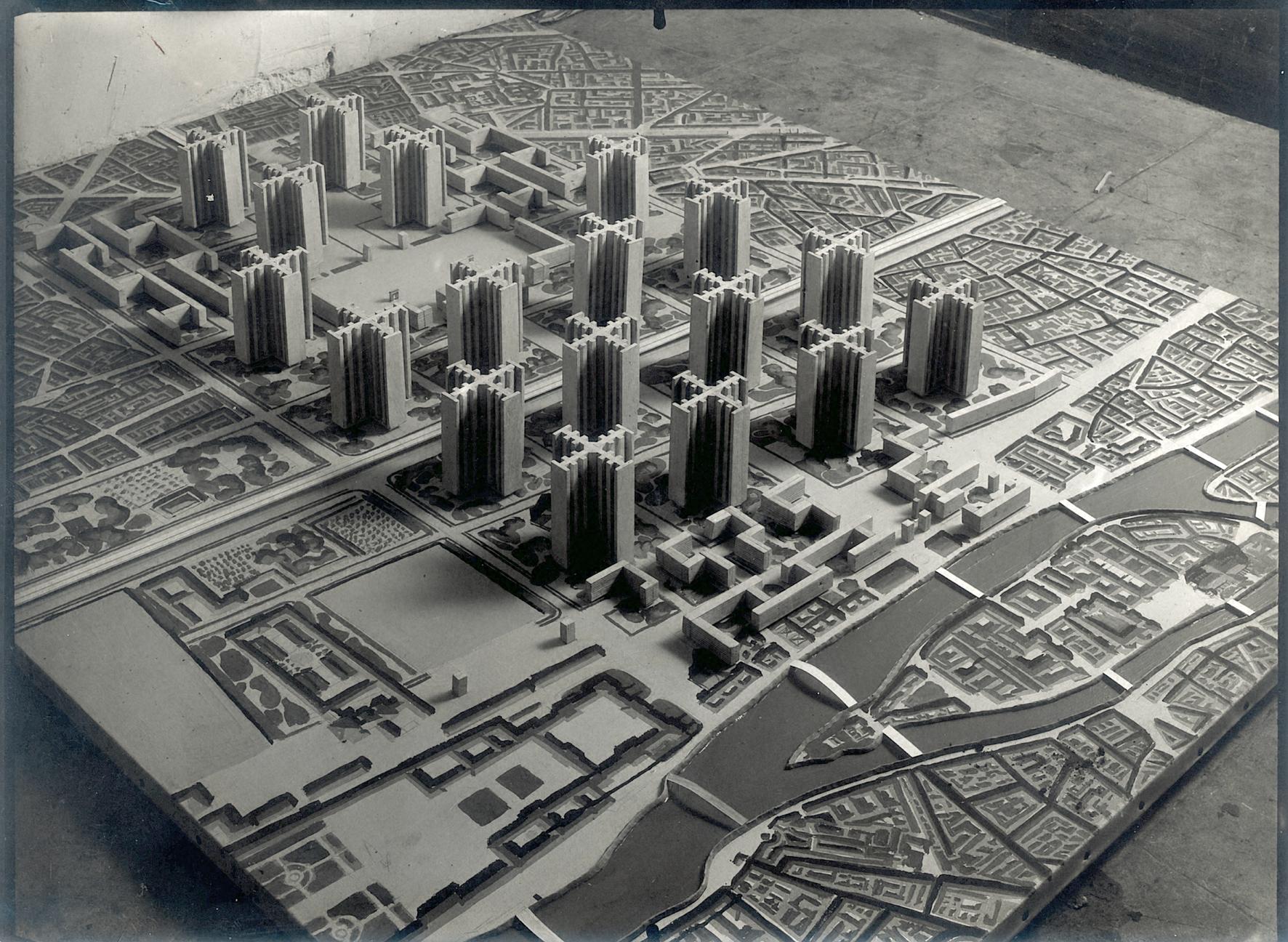
Le Corbusier’s Plan Vousin of 1924, a perverse step-child of Cerda’s plan of building the city through uniform blocks. There is meant to be no street life. Photo courtesy of Richard Sennett.
This is Corbusier’s Plan Viosin made for the Marais in Paris in 1924–25. The Marais was graded flat and these identical, beautiful 18 storey towers put in their place. This is one of the first structural features of a closed system: it’s additive. There is no interaction here which makes the ensemble greater than the sum of its parts. There is nothing what Aristotle first called synoikismos in a city, which we now think of as the word ‘synergy’. This kind of investment is very attractive to global capital.
At every tight fit between form and function, technological obsolescence will occur, and that’s what the people in the media lab knew. That was what was fundamentally wrong with the Microsoft way of thinking. Something that works really well is also something that’s going to be discarded in time.
This is what we can learn from the Beijing housing estate. They were built at a time when the Chinese leadership wanted one child families. Now, they want two or three children families because society is ageing and they need more workers to keep the economy growing. But this housing estate is very rigid in form. We have done a lot of costing on this. It will be cheaper to knock all of this housing down and build it fresh than to try and deal with the tight specifications of this design. It’s just the same problem of obsolescence: when you have a real fit between what a thing is and what it’s meant to do. The challenge is to loosen up.
From borders to opening up
The task is to think about what can make forms more flexible as people live in different ways. I’ll show three projects I have been involved in. The first thing we are interested in are edges between different areas in cities. Edges come in two forms: borders which are porous and boundaries which, like Trump’s wall, non-porous. They have a natural reference, as in ‘edge conditions’, meaning where land meets water. The actual edge here is an area of intense biological activities, sped up evolution. Its hallmark is that it’s porous. Our question is how to create that porosity in an urban environment.
Here is an example from the capital of Venezuela: between the bourgeois part of Caracas and the slums, the so-called Barrio Caracas, the edge condition is a three lane highway where the flow of traffic cuts people off. There is one bridge, where maids cross in the morning to go to service apartments. In the evening they go back over the bridge. There is no interaction in the opposite direction.
Building this highway was a project of Hugo Chavez, and our task was to make it more porous so to abolish this isolation. Beside building several bridges, we also located public services at the edge itself. A health clinic that can be accessed by people living in the Barrio; taking some of the buildings down to build schools for small children which poor and rich might as well use. We did not focus on commercial activity, but placed government offices throughout the city. We are also trying to shrink the highway from three lanes to two, and one day, I hope, to one.
This way, we open up a city by transforming edges more into borders than boundaries. Richard Burdett and I, along with others from the London School of Economics, have been pursuing this project for many years. We are interested in how a space can open up using the very same amount of land, the same density of population. How do you create a more flexible set of forms, so as to allow for open space, lots of entrances and exits. In this experiment we are loosening the relationship between form and function.
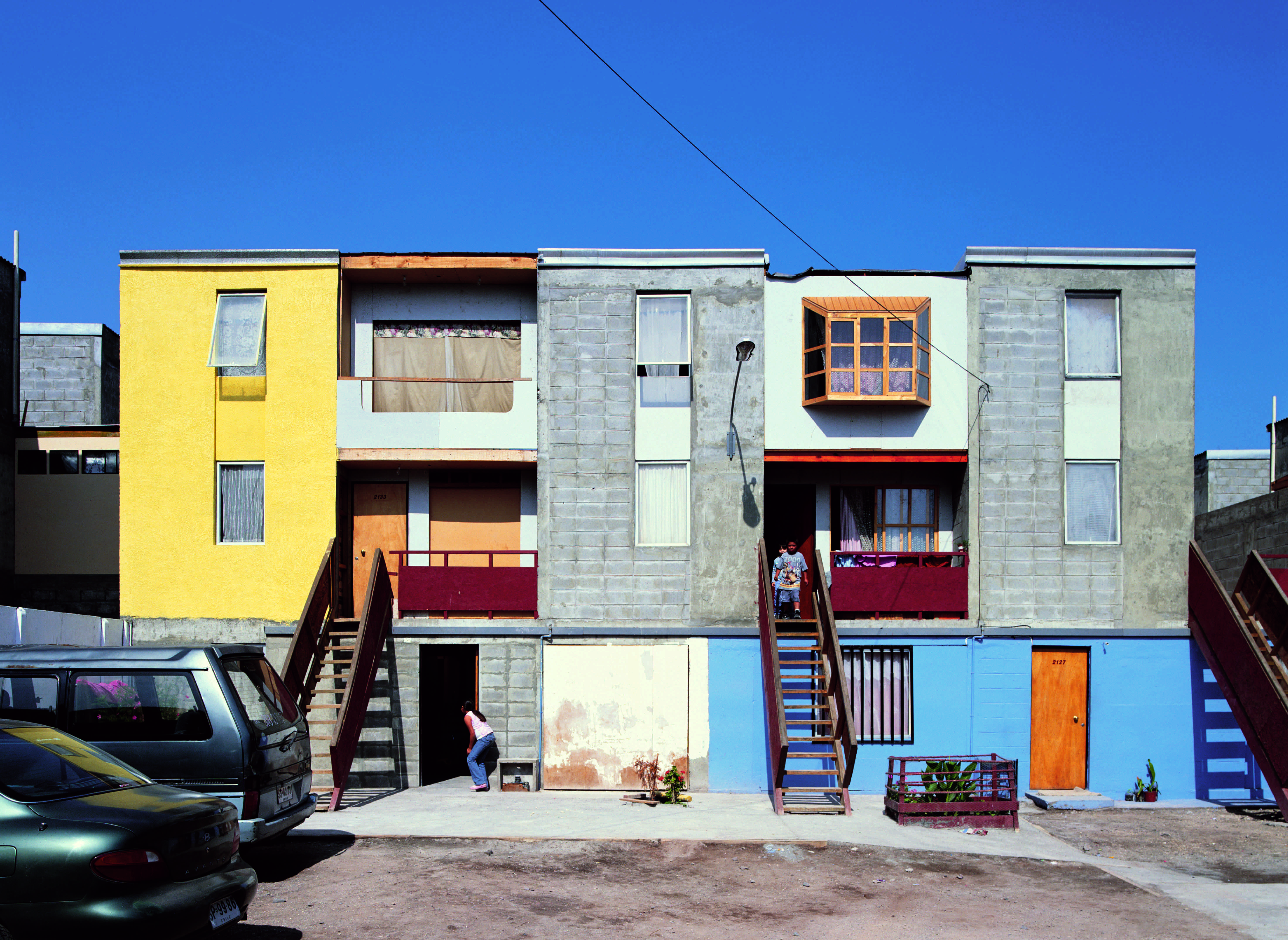
When completed, the result is an architectural disaster but an economic and sociological success. ‘Open’ is not an aesthetic measure. Photo courtesy of Richard Sennett.
Certain features can be remade very simply: it’s a technical exercise, it takes a lot of expertise in order to make something more sociable. Another issue is how to think about incomplete forms. A classical approach is a project by Enrique Aravena in Iquique, Chile, which aimed at raising the standards of self-built housing, to give people the infrastructure for a good quality house and let them fill it in themselves, instead of building poor quality, readymade housing for them.
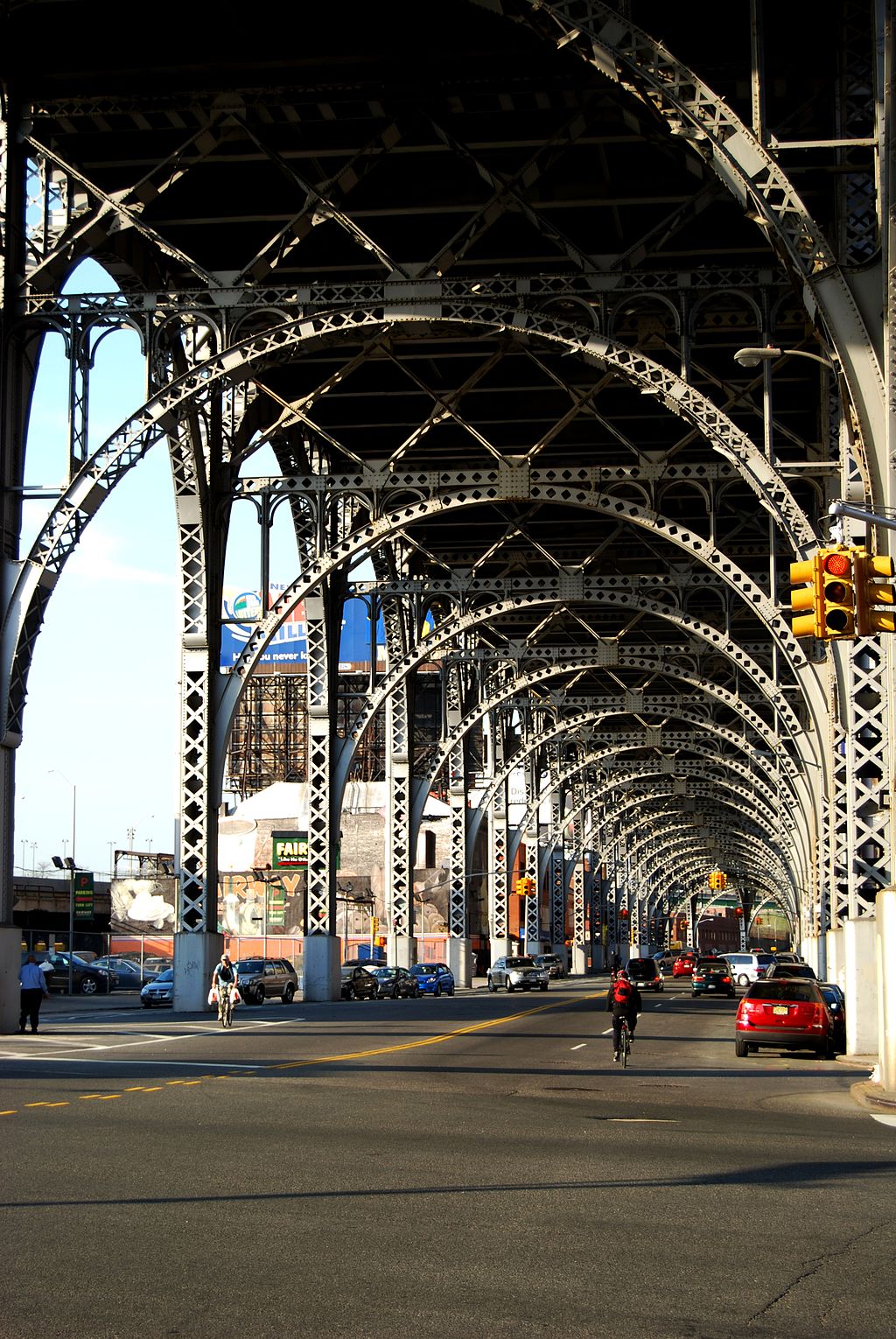
Riverside Drive Viaduct. Photo source: Wikiwand
What I’m interested in is how we can think about city infrastructure as an incomplete form, how we can utilize it. Here is an example from the planning commission of New York, about a highway overpass. On one side, you have Columbia University, on the other side lies Harlem. The people of Harlem seldom met folks of Columbia. We then put a grocery store underneath the highway. To me it looks beautiful. If you want to buy a box of milk you may use the same facility as somebody of a different race.
The word ‘developing city’ often suggests that there is nothing there in these cities, there was empty land before these masses of people began flooding into cities. That’s not true. In many places you have abandoned land or abandoned structures that have proven unproductive, but the owners hold on to them hoping that somebody will find some use for them. In the meantime they are colonized by the poor. Development that happens in an empty space is fantasy. We are thinking of ways to utilize public space to create something that makes city out of an abandoned lot, but has the porosity to it.
Urban cosmopolitanism
Finally, let me show you this picture. This is Jane Jacobs and me having a drink in the White Horses Tavern.
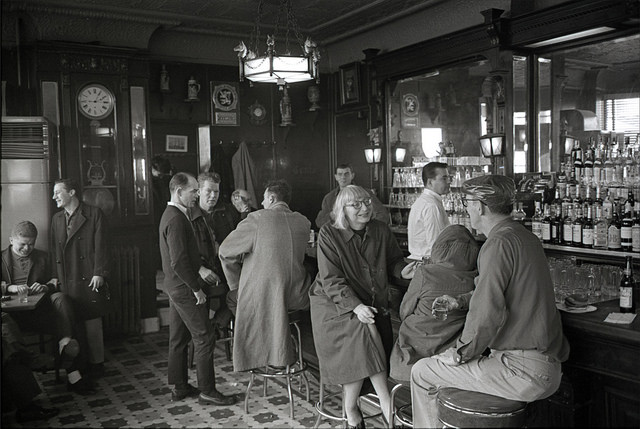
Unlike Olmsted, Jacobs preferred social spaces tied to street life. In the Whitehorse Tavern in Greenwich Village she chats happily with the author, unperturbed by the drunk who had passed out between us. Photo courtesy of Richard Sennett.
She was my mentor and the greatest urbanist, I think, of the last century. But from an urbanist perspective, the most important person here is this guy slumped over, drunk out of his mind. Seeing him there I, being a boy, said, ‘Don’t you think we should call a doctor to get some help?’ And she said, ‘Why are you so provincial? Let him be. What right do you have to interfere with somebody? He is snoring away, he’s not doing you any harm.’
That is the cosmopolitan attitude about difference. Every time I look at this photo, the drunk man is the focus to me. He represents the notion that a city can embrace people who are different not in a nice liberal way, but disturbingly different, and they can live together.
Our last project has to do with climate change. You remember how hurricane Sandy in 2012 inundated New York City? The question arose, how to deal with the effects of climate change. We know the long term effects: sea levels rising, desertification, which affects many cities as their water tables disappear, and so on. But we don’t know what to expect from storms, because it’s a nonlinear development. We can’t predict that on 14 November there will be this storm. There’s no way to do that, because it is a chaotic system in its functioning. But not in its results. That poses the question about how to deal with climate change in terms of adaptation or modification of existing forms.
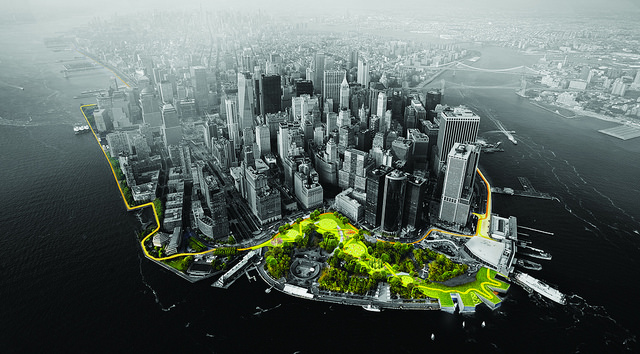
Open and closed in climate change: in the wake of Hurricane Sandy in 2017 in New York, a proposal by Bjarke Ingels Group to create a huge berm – a built-up mound of sand – around the southern tip of Manhattan. Photo courtesy of Richard Sennett.
This is a project by Bjarke Ingels called the ‘Necklace’: the idea is to create a brim around the southern tip of Manhattan. The problem is that it’s based on a prediction which has already been falsified: a prediction of how high the wall should be in order to protect the people beyond it. Beside its advantages, it carries an aspect of closure, as if you could build your way out of climate change.
My group at MIT has a different approach to installing brims. We suggested building a system of planted brims outside of Manhattan itself to mitigate the force of erratic storms and, even more, to recover from them. We don’t try to build our way out of climate change, but rather to work with it in an open way, meaning that we focus on the edges of the city that are indeterminate and porous.
Closure is a way to build yourself out of a problem. And even something so wonderfully sophisticated as Bjarke Ingels’s brim is a way to build yourself out of climate change. Whereas our project, which is founded much more on open system principles, is a way to work with climate change to create a system of small scale resistances.
Inclusion before beauty
I have first shown you the structural conflict between building and dwelling, and a structural asymmetry which cannot be healed by an appropriate design to provide people justice and community at the same time. These are structurally dissonant. Second, I told you about what urban democracy means for me, and how to open up the city rather than close it down. This idea, founded on systems theory, is not an aesthetic approach. The results of opening thing up are sometimes very ugly. We’re not talking beauty here, we are talking something more participatory and inviting for people. In the third part, I have shown you some of our work in the UN over the years, as examples of what openness and closure looks like in emerging cities.
In conclusion, I would like to talk about what I think of as the philosophical underpinning of all of this. I think that the great measure of closure today is that people don’t feel that they can deal with complexity, differences, people that they don’t like, situations which are unfamiliar. This incapacity to deal with difference feeds into a capitalist economy that can profit from making people want to do only what is comfortable and familiar to them. I don’t mention Facebook, but it is immediately obvious what that is. Facebook is a system of closure among friends, likes, with its vampire technology to benefit from that.
This is no political formula, but the reason why I think of cities as potential schools for people to feel more competent. It is precisely because of the complexities of cities, that people who dwell in them can feel more competent, to be able to handle it or, as we would say in American English, to not be destroyed when you suddenly see a black person or a refugee on the street. I think a lot of the political difficulties result from this confluence between the desired withdrawal and an economy that makes money out of personalization, out of comfort, out of ease of use. User-friendliness is a terrible, terrible idea. User-friendly means that you don’t have any stimulation.
A city should not be user-friendly. It should be a place where you learn how to deal with a difficult situation and with other people – that is what makes a city really open.
This essay is based on Richard Sennett’s Democracy Lecture, hosted by Blätter für deutsche und internationale Politik, on 8 November 2018. The images featured in the article are a courtesy of the author.
